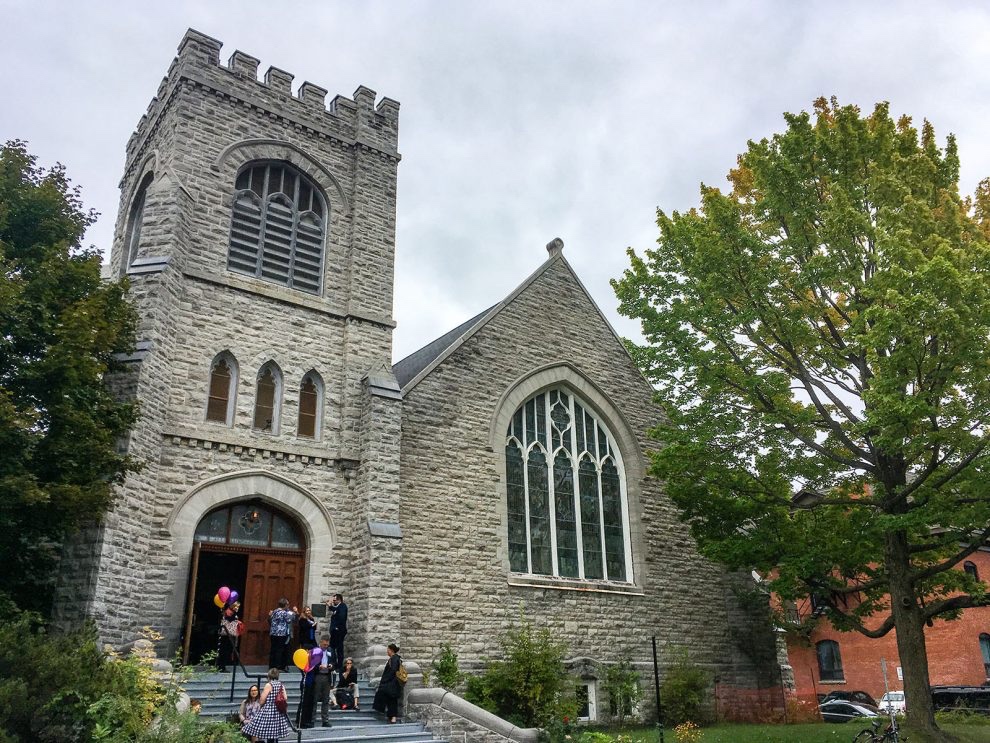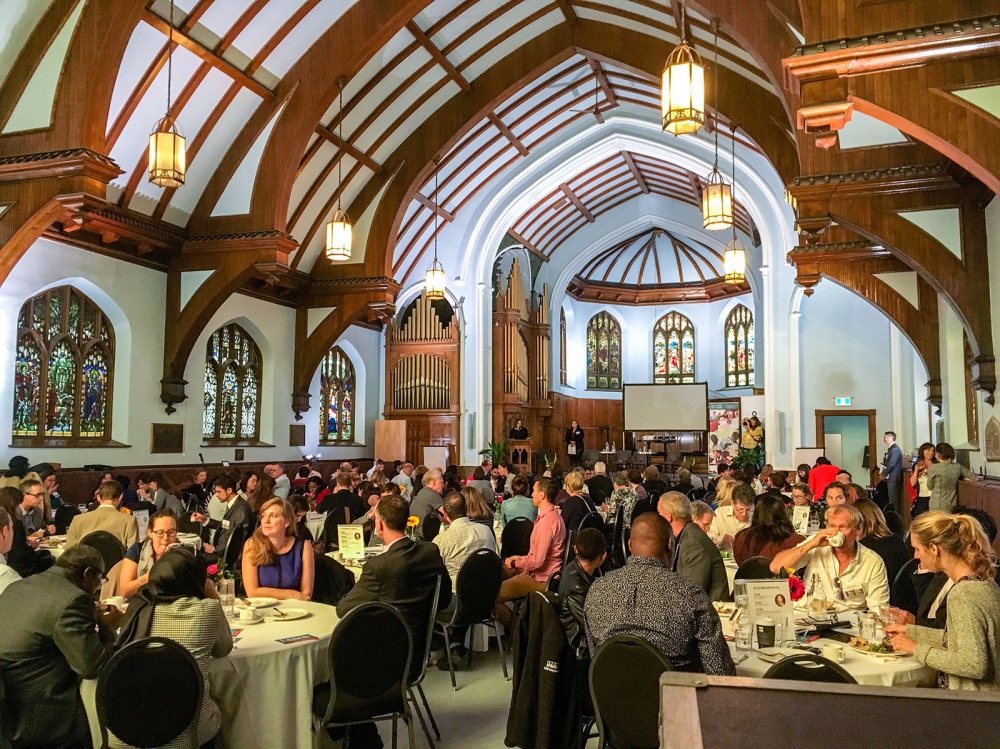
JOHN LONGHURST reports for Religion News Service…
Winnipeg, Canada
RNS
As many as a third of Canada’s houses of worship – about 9,000 churches, synagogues, mosques and temples – could be in danger of being demolished over the next ten years.
That’s an estimate from the National Trust for Canada, a nonprofit group dedicated to preserving historic buildings in that country.
“It’s a trend we’ve been noticing for the last few years,” said Robert Pajot, regeneration project leader with the National Trust. “The pace seems to be accelerating now.”

A meeting of the Canadian Council for International Cooperation fills allsaints event space, formerly All Saints Anglican Church, in 2018. PICTURE: John Longhurst/RNS
The estimate is based on the Trust’s own research, news stories and other reports about church closings. One reason for the decline in houses of worship is the “growing secularism in Canada,” said Pajot, which means that fewer people are attending services.
Natalie Bull, executive director of the National Trust, pointed to aging congregations and “dwindling dollars in the collection plate.” As a result, houses of worship have become an endangered species.
“Thousands of these buildings are doomed.”
Natalie Bull, executive director of the National Trust in Canada.
“Thousands of these buildings are doomed,” Bull said.
Faith groups are the second-largest real estate holder in Canada – second only to the Government of Canada itself, according to the National Trust. Bull said denominations, congregations, governments and heritage groups need to start working together to decide the fate of shuttered churches and other houses of worship.
Those buildings, she said, are “more than just landmarks. They carry family memories and meaning.”
Since churches or other houses of worship often house programs – such as soup kitchens, homeless shelters, tutoring programs and other outreach ministries – the whole community can lose when a congregation shuts down.
Bull would like to see shuttered churches and other houses of worship converted to things like office space for non-profits, food banks, community centers, affordable housing or other functions.
“What a blessing it can be when a former place of faith continues to serve the community,” she said.
That’s what happened at St Matthew’s Anglican Church, located in Winnipeg, a city of 750,000 in the prairie province of Manitoba.
Built in 1908, membership and attendance peaked after World War II when as many as 1,200 came to services on Sunday at the downtown church. As members started moving to the suburbs in the 1960s, attendance began to fall. By 2003 there were only about 85 people left.
That’s when the church, which had a long history of serving the surrounding area, had to decide what to do with its big, old, tired building.
“We faced a stark choice,” said Cathy Campbell, who was the parish priest from 2003 to 2015.

A meeting of the Canadian Council for International Cooperation fills allsaints event space, formerly All Saints Anglican Church, in 2018. PICTURE: John Longhurst/RNS
Even though the structure was in serious need of repair, Campbell said the congregation did not want to see it torn down. But they didn’t have the funds to repair it on their own. And they still wanted the space to serve the community.
The church worked with different levels of government, foundations and private donors on an $8.5 million CDN plan to convert the former sanctuary into 26 affordable apartments over four floors, along with space for various local organizations.
The building – now called the West End Commons – also still functions as a place of worship, housing five different congregations in a new worship space.
“We had a big goal to not leave a derelict building in a challenged neighbourhood,” said Campbell. “We didn’t want to signal a downward spin. Now we are signaling an upwards spin.”
In Ottawa, the historic All Saints Anglican Church, built in 1899 in the capital city’s Sandy Hill neighborhood, also faced an uncertain future. The dwindling congregation merged with another church in 2014. A year later the building was sold for $1.52 million CDN to a local group and was turned into allsaints event space.
“We worked with the community to repurpose it,” said Leanne Moussa, president of allsaints Developments Inc., of how the building was saved and turned into a venue for weddings, funerals, parties, conferences, theatre, concerts and other events.
The building is also rented by a couple of congregations. For a short time, it was also home to a Muslim congregation.
“We had a big goal to not leave a derelict building in a challenged neighbourhood. We didn’t want to signal a downward spin. Now we are signaling an upwards spin.”
Cathy Campbell, who was the parish priest of St Matthew’s Anglican in Winnipeg.
“We’re excited about what we were able to do here in Ottawa,” Moussa said.
In Alberta, the Calgary Inter-Mennonite Church decided to repurpose its space to serve its neighborhood better and earn additional revenue to keep the 1960s-era building viable.
Now called Theatre 1308, their building features a professional lighting and sound system, HD projector and screen, microphones and floor monitors.
According to General Manager Graham Neumann, the congregation of about 50 began talking three years ago about how to make better use of its space.
“We felt [the] space was underutilised; it sat empty six days a week,” he said.
At the same time, the northeast Calgary neighbourhood where the church is located was revitalizing, with trendy restaurants and shops starting up.
“We wanted to be part of that,” he adds, noting Calgary also lacked smaller, well-equipped arts spaces. Creating the new arts space also helps the congregation with upkeep and maintenance, as the costs of running the building are spread around, said Neumann.
“It spreads the costs of running the building further,” he said, and can be a hedge for the future if the congregation declines.
For Bull, all these efforts are laudable. She knows not all churches can be saved. But she is hopeful that some will be.
“I’m under no illusion we can actually turn the tide,” she said.
“My hope is that faith groups and their communities will do our very best to make wise use of these sacred spaces that we’ve inherited from the past.”






